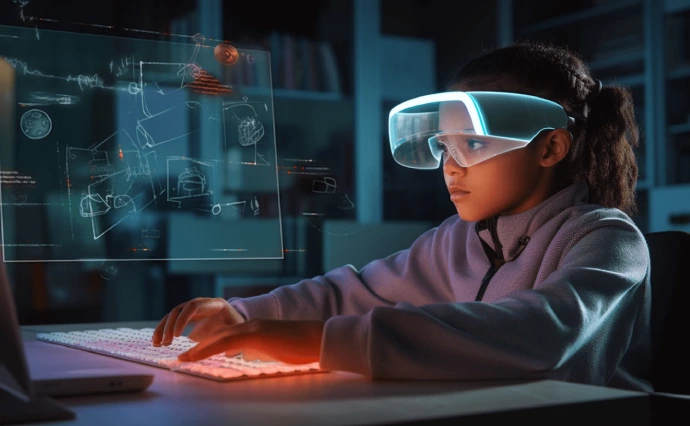Advanced Technology in Education: Integrating Artificial Intelligence
In recent years, advanced technology in education has made learning more interesting and helpful. One of the most exciting new tools is Artificial Intelligence (AI). AI refers to computer systems that can do tasks that normally need human intelligence. This includes things like understanding language, recognizing images, and learning from data. In education, AI is being used to help students learn in a way that fits their own speed and needs.
AI-Driven Adaptive Learning Systems
AI helps create adaptive learning systems. These are systems that adjust to each student’s needs. Imagine you are learning math, and you get stuck on a problem. An AI-powered system can give you extra practice on that topic. If you do well, it can move you to harder questions. This makes learning more personal and helps each student do their best. Adaptive learning helps students avoid getting bored or frustrated because it matches the work to their level.
AI in Grading and Assessment
One of the most useful ways advanced technology in education is being used is in grading and assessments. AI can quickly grade tests, saving teachers time. This is especially helpful for multiple-choice and short-answer questions. Some AI systems can even grade essays by looking at grammar, sentence structure, and content. With AI, teachers can give students feedback faster, which helps students improve more quickly.
Virtual Teaching Assistants and AI Tutoring
Virtual teaching assistants are another part of AI in education. These assistants are AI programs that can answer questions from students, much like a real assistant. For example, if a student asks, “What time is my math assignment due?” the virtual assistant can give an answer. Some AI tutors are also available for extra help. They can answer questions and explain concepts if students are having trouble. This makes learning more accessible because students can get help anytime, not just during school hours.
Benefits of AI in Education
The main benefit of using advanced technology in education, like AI, is that it makes learning more personal. Every student learns differently, and AI can adjust lessons to help each person learn in the best way for them. AI also saves teachers time on tasks like grading, so they have more time to help students understand difficult topics. Additionally, AI can help students who might be too shy to ask questions in class by giving them a way to learn on their own.
Challenges and Privacy Concerns
While AI offers many benefits, there are also challenges. One big concern is data privacy. For AI to work well, it needs a lot of information about students. This data includes things like grades, behavior, and learning habits. Schools need to make sure this data is safe and that only the right people can see it. Another challenge is cost; not all schools can afford advanced AI systems. It’s also important to remember that AI cannot replace teachers. Teachers still play an essential role in guiding and supporting students.
Future of AI in Education
The future of AI in education looks very promising. As technology improves, AI will likely become even better at helping students learn. We may see more advanced virtual tutors and systems that understand each student’s strengths and weaknesses. Schools may also find ways to use AI safely and affordably. In the future, AI could make education more effective, allowing every student to reach their full potential.
Advanced Technology in Education: The Impact of Virtual Reality (VR) and Augmented Reality (AR)
Advanced technology in education includes amazing tools like Virtual Reality (VR) and Augmented Reality (AR). These tools make learning more interactive and fun. VR creates a 3D, computer-generated world that students can see and explore through special headsets. AR, on the other hand, adds digital information to the real world, often through a phone or tablet screen. Both VR and AR bring learning to life, making subjects easier to understand and enjoy.
How VR and AR Make Learning More Exciting
VR and AR make learning exciting by immersing students in what they are studying. For example, if students are learning about ancient Egypt, they can put on VR headsets to “visit” the pyramids. They can look around, walk through tombs, and see what life was like thousands of years ago. With AR, students can look at a picture of the solar system on a tablet and see the planets moving around the sun right in front of them. These experiences make learning feel like a game and help students remember what they learn.
VR and AR in Science, History, and Geography
Advanced technology in education like VR and AR is especially useful in subjects like science, history, and geography. In science, students can explore human cells or travel inside a volcano. In history, they can “visit” famous events and see how people lived in the past. For geography, VR can show landscapes like mountains, rivers, and forests, helping students understand how places look around the world. This hands-on learning helps students grasp difficult concepts.
Benefits of VR and AR in the Classroom
One main benefit of using VR and AR in education is increased engagement. Students are more interested and focused when they use these tools, making it easier for them to learn. VR and AR also support different learning styles. Visual learners can benefit from seeing information, while kinesthetic learners enjoy moving around and interacting with digital objects. This makes learning inclusive, giving all students a chance to succeed.
Challenges of VR and AR in Education
While advanced technology in education like VR and AR has many benefits, it also comes with challenges. One big challenge is the cost of the equipment, like VR headsets and AR tablets, which some schools cannot afford. Additionally, some students may experience motion sickness or dizziness from using VR. It’s important for schools to think about these challenges and find ways to make VR and AR safe and affordable.

Students benefit from advanced technology in education tools like VR
Advanced Technology in Education: Cloud Computing in Education
One powerful tool in advanced technology in education is cloud computing. Cloud computing allows students and teachers to store, share, and access information over the internet instead of on a personal computer or device. Examples of cloud services in education include Google Classroom, Microsoft Teams, and other online platforms. With cloud computing, students and teachers can access their lessons, assignments, and projects anytime and from anywhere.
Benefits of Cloud Computing for Students and Teachers
One major benefit of cloud computing in education is easy access. Since everything is online, students can work on assignments from home, school, or any place with internet. Teachers can also share materials like videos, notes, and homework quickly. This is especially helpful for group projects where students need to work together. Instead of meeting in person, students can work together on the cloud, making it more convenient and flexible.
Cloud Computing and Remote Learning
Cloud computing has become even more important for remote learning. When schools closed during the pandemic, many students studied from home. Cloud computing made this possible. Teachers could post lessons, assignments, and tests online, and students could turn in their work through platforms like Google Classroom. This helped keep learning going even when students were not in school. The cloud made it easier for everyone to stay connected and continue learning.
Challenges of Cloud Computing in Education
Although advanced technology in education has many benefits, cloud computing has its challenges. One challenge is internet access. Not all students have strong internet at home, which can make it difficult to access cloud-based lessons and assignments. This creates an inequality where some students have more resources than others. Another challenge is data security and privacy. Schools have to be careful about protecting student information on the cloud so it stays safe from hackers.
The Future of Cloud Computing in Education
As technology keeps improving, cloud computing will likely become an even bigger part of education. Schools may start using more advanced cloud tools to create interactive and collaborative lessons. Cloud computing can make learning more accessible and flexible, helping students and teachers get more from their lessons. Educational technology in education continues to grow, and cloud computing is helping to make learning easier and more available for everyone.
FAQs
Q: What is advanced technology in education?
Advanced technology in education refers to tools like AI, VR, AR, and cloud computing that enhance the learning process by making it more interactive and personalized.
Q: How does AI impact education?
AI in education provides personalized learning paths, helps teachers with grading, and offers virtual tutoring, making education more tailored and efficient.
Q: What are the benefits of using VR and AR in education?
VR and AR help students experience lessons more vividly, allowing them to explore concepts in immersive environments, which improves engagement and retention.
Q: How does cloud computing benefit students and teachers?
Cloud computing enables easy access to assignments and materials, fosters collaboration, and supports remote learning, which makes education more flexible.
Q: What are the challenges of using advanced technology in education?
Common challenges include data privacy concerns, accessibility, and the cost of devices like VR headsets and reliable internet access.
Q: Is cloud computing safe for student data?
Cloud computing can be safe when schools use secure platforms and follow data protection policies, ensuring student information stays private.
Q: What does the future hold for advanced technology in education?
advanced technology in education will likely continue to grow, with more schools adopting AI, VR, AR, and cloud solutions to support a modern learning experience.
Conclusion:
In conclusion, advanced technology in education is making learning more engaging and tailored to students’ needs. AI helps students learn at their own pace, gives teachers more time for personalized support, and makes learning available anytime. While there are challenges, the future holds great potential for AI to help make education better for everyone.
The future of VR and AR in education looks promising. As technology becomes more affordable, more schools may use VR and AR to make learning exciting and interactive. Educational technology in education is helping students experience the world in new ways, making learning more enjoyable and effective.
cloud computing is a valuable part of advanced technology in education. It allows students and teachers to connect, share, and learn from anywhere, making education more flexible. Although there are challenges like internet access and security, cloud computing has the power to make learning easier and more engaging for students around the world.



